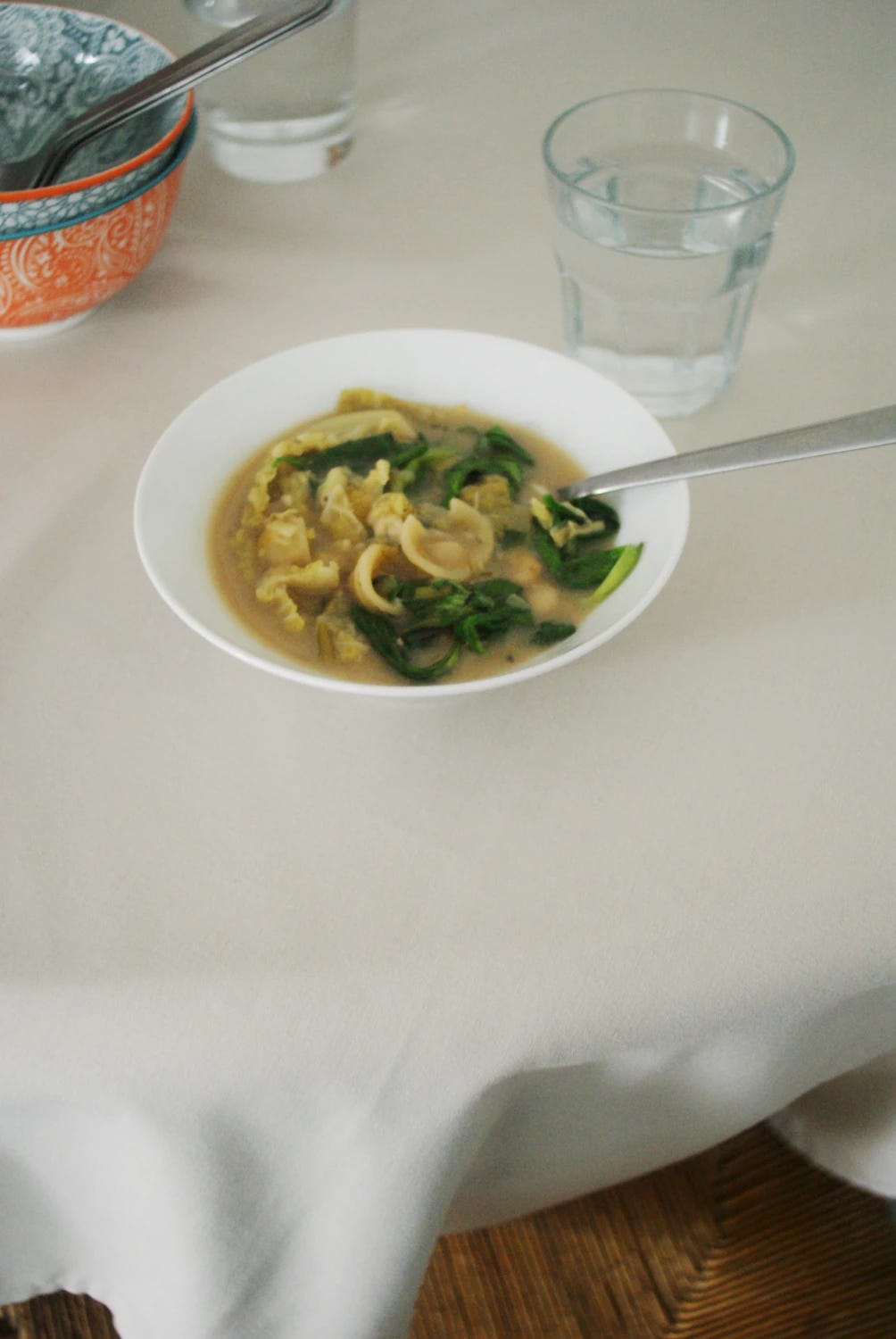In January, it goes with the territory that I feel squishy and rotund and like I’d melt in greasy ripples if someone threw me into a frying pan. This hasn’t slowed my eating debauchery however. That is, until I rustled up a winter vegan minestrone soup, a green, fresh one, full of spinach and leeks and cabbage, not a speck of parmesan or tomato in sight, and now I feel virtuous, almost born again.
This time last year, I was a superhero with a stick-blending superpower, whipping up breakfast smoothie after breakfast smoothie full of ginger and beetroot and turmeric, all those superfood buzzwords that make me feel healthy just thinking about them. Looking back, I think I was addicted to health. I even learnt that black pepper activates the speed turmeric is absorbed by the body so I started using my pepper grinder on those smoothies, feverishly grinding away to the mantra of “must… be… healthy”. I still make those smoothies, in fact I just guzzled a banana and peanut butter one – with turmeric and black pepper because old habits die hard – but my health-hunting mojo has been broken.
Last year, I found cooking was all about how much ginger or turmeric I could add to foods before it tasted disgusting. This year, on the other hand, I’ve been gorging on a forgotten advent calendar. You see, I started 2023 on an anti-inflammatory diet – I tried, I really did but I should have known it was doomed to fail. Dear reader, if you live in France where baguettes and pastries are a form of edible currency, and also if after three months all you crave are takeaway noodles, diets take a pretty abrupt nosedive.
So, as a result I haven’t even tried this year – although one thing I can thank the anti-inflammatory escapades for is the increase of beetroot in my diet (chicken and chips for dinner? Just slap a beetroot on the side, it stops the 5-a-day guilt in its tracks). However, this is the month notorious for dieting, guilt, and general pressure to do and be better. Beetroot is my step towards being a better person and hopefully not dying young. But beyond that, I’ve not been making much headway in the virtuous Olympics.
#newyearnewme doesn’t have the same deafening fanfare it did seven years ago when I started this little blog, although now it’s almost more sinister, simmering under the surface whenever someone says they’re doing Dry January and you suddenly feel like you’re failing at everything in life. In fact, I am doing Dry January but this is certainly not to make you feel inadequate dear reader, because can I really say it’s been successful if we’re not even at the end of the month and I’ve already had a cider, a wine, and a cocktail?
In the UK, there is one more thing to feel a little bit more guilty about – Veganuary has began and has now become a global event with records breaking due to the number of sign ups.
I’ve climbed onto my soap box about this a fair few times so I’ll try to be brief if you can bear with me. Veganuary is a month-long challenge to eat a vegan diet. I personally believe veganism needs more exposure and good press – there are so many foods out there that happen to be vegan that can have me in raptures, but so much of the world turn their noses up at the very idea. We all need to taste and to educate ourselves.
This year’s Thanksgiving – a holiday known for its meat and dairy produce – courtesy of my lovely friends Nikita and Rhody, was almost exclusively vegan. Then only last week, Nikita and I shared vegan chocolate-stuffed cookies as we worked on her novel, cookies that if I hadn’t bought (and combed the shelves for as this is the land of butter) I wouldn’t have known were plant based.
However, a 31-day challenge in January I believe is setting people up to fail. This is the month when seasonal affective disorder is written on everyone’s faces as they trudge to and from work in the dark. There are no parties, only hibernation and Dry January and now not even melted cheese to comfort us. (Unless you’re Rhody who’s an accomplished vegan-cheese maker.) As soon as Feb 1st rolls round, everyone’s going to be found at the pub or smothering themselves in raclette. And it makes you wonder what the point was.
We can’t avoid the January guilt and the challenges to improve ourselves and our lives. So, let’s take them by the horns and try Veganuary and Dry January, try an anti-inflammatory diet if you must, but let’s give ourselves time to make mistakes, to have that cheeky cocktail because it’s the first time you’ve been out in a week. And that’s why this month I made a toad in the hole to start the year – not the healthiest dinner by any means, but warming and comforting, as my friend Suzie said, basically the food equivalent of a hug – then built up my confidence and cravings for fresh vegetables to make this hearty winter vegan minestrone soup.
Winter Vegan Minestrone Soup Without Tomato
First of all – why without tomato I hear you ask? I promise, I don’t have a problem with tomatoes – except maybe the ones you can buy in plastic packaging in a Tescos Express in London because they are as flavourless and watery as ice cubes – but they do not strike me as the slightest bit wintery. And this is a winter minestrone soup after all.
Classic Italian minestrone under all its various guises is a brothy tomato soup full of beans and diced vegetables and the all-important spirals of pasta, served with grated parmesan. It’s an excuse to dress up a pasta-and-cheese dinner and call it healthy, essentially the perfect way to delude ourselves in January. However, that cheese is barely even vegetarian let alone vegan, and right now I am craving more creamy, soothing flavours rather than the sharp acid of tinned tomatoes.
This winter vegan minestrone soup, while it won’t win any beauty pageants, is one that makes your spoon heavy; it’s so loaded with vegetables and beans and pasta it’s basically a stew. You have to bring your face close to your bowl for the shortest possible journey to your mouth, a winter dish if ever there was one.
In here, there is a pile of greens to help us feel morally good – leeks, celery, cabbage, spinach, even the celery leaves for a bite of sharpness. The beans add an irresistible creaminess, taking the soup out of gruel territory, making it filling and substantial. I started off with bread on the side but this just proved to be unnecessary greed, something to soak up the hot broth as I impatiently waited for it to cool, but all the fillings take this soup out of the liquid lunch category and make it stodgy, full of different textures to chew on.
When it comes to the brothy base of vegan soups, I tend to rely on vegetable stock cubes but this is often too uniformly salty – therefore, for this minestrone soup which needed a bit of vigor, I used dried porcini soaked in boiling water as well as a stock cube. Their earthiness added complexity which honestly matures with every reheating of the soup – this has been my lunch now two days in a row and I’ll probably have more for dinner tonight as it just keeps getting better.
I topped my serving just now with a spoonful of pesto – which certainly ain’t vegan – but the whole point is to try, to work out what we enjoy eating and to challenge ourselves while we have the motivation. And a winter vegan minestrone soup might just be the starting point this January.
Winter Vegan Minestrone Soup
The long list of vegetables does a disservice for how easy this soup is to make – simply chop and bundle everything into a pan, and before long you have soup ready to serve.
If you're not serving it straight away, feel free to make the soup base of vegetables and beans hours or a day before and keep it in the fridge until ready. Then add the extra water and pasta to cook, then finish with the spinach.
When reheating, add a splash of water to loosen everything.
Prep Time: 10 minutes
Cook Time: 30 minutes
Course: Dinner, Lunch, Main Course
Cuisine: Italian, Vegan
Keyword: beans, leek, pasta, spinach, stock
Servings: 4
Ingredients
1 leek, without the leafy ends
1 stick of celery - reserve the leaves to add to the soup at the end
1 tbsp olive oil
2 garlic cloves
1 tsp fresh rosemary, finely chopped
2 tbsp dried porcini mushrooms - optional (they are quite expensive so don’t feel like you need to break the bank)
1.25 lt boiling water
1 vegetable stock cube
1 bouquet garni
400 g can or jar of white beans (e.g. cannellini), drained and rinsed
90 g pasta any shape, I used orecchiette – the small ear-shaped pasta
100 g spinach and the leftover celery leaves if you wish
Salt and black pepper
Instructions
Chop the leek into thick slices, then rinse in a colander to remove any grit, and finely dice the celery.
Warm the olive oil in a large saucepan or casserole dish over medium heat. Once hot, add the chopped leek and celery. Lower the heat and cook, stirring regularly, for around 10 minutes until the leek is soft.
Meanwhile chop the garlic cloves into thin slices. Add the garlic and rosemary to the vegetables and cook for 30 seconds to release their fragrance. Lower the heat.
Combine the dried porcini with 400ml (around 2 cups) of the boiling water. Leave to soak for 1 minute then pour it all into the saucepan. Stir to loosen any leek or celery stuck to the bottom of the pan then add the crumbled vegetable stock cube and another 500ml of the boiling water. (If you're not using the porcini, add around 1 lt boiling water with the stock cube.)
Increase the heat to high and bring the soup to a boil. Add the bouquet garni and the drained and rinsed white beans. Stir everything together and let it boil for 5 minutes. Season with salt and black pepper.
At this point, if you are not serving the soup on the same day, you can leave it to cool and then place it in the fridge overnight. This allows the flavours to macerate and brood a bit.
When you're ready to add the pasta, add the rest of the water, bring the soup to the boil and pour in the pasta. Cook according to packet instructions. When the pasta is al dente, add the spinach and celery leaves if using and stir into the soup to wilt. Season with a little more salt.
Serve the minestrone soup with a spoonful of pesto on top if you wish – vegan or otherwise.






